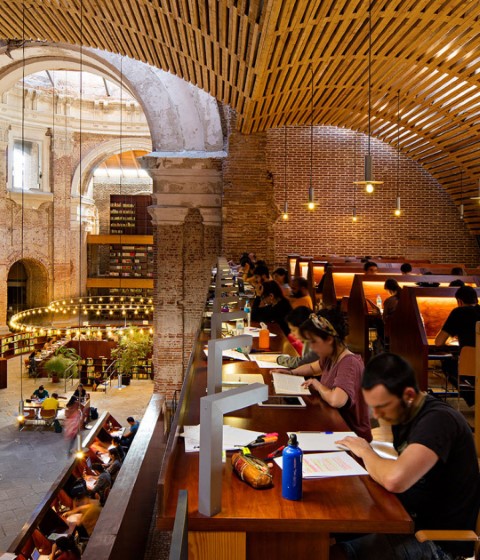A building that is defined by its wall condition and texture, whose materiality is characterized by concrete with a reddish pigmentation that, according to the architects, “calibrates its mass” and allows it “in apparent opposition its transparency”.
The design researches the possibility of generating meeting spaces, from its external stairs creating patios and public corners, which take advantage of the perforations as meeting places and generate squares.

Library of Sciences, Engineering and Architecture PUCP by Llosa Cortegana Arquitectos. Photograph by Juan Solano.

Library of Sciences, Engineering and Architecture PUCP by Llosa Cortegana Arquitectos. Photograph by Juan Solano.
Project description by Llosa Cortegana Arquitectos
"...perhaps old age and fear fool me, but I suspect that the human species - the only one - is about to be extinguished and that the library will endure; illuminated, solitary, infinite, perfectly motionless, equipped with precious volumes, useless, incorruptible, secret."
The Library of Babel. Jorge Luis Borges
The library has always been a container of memory, of the reality of culture and at the same time, it has been its refuge. This double condition has marked its uniqueness.
Established on the Campus of the Catholic University of Peru, the project arose from its circumstances, from the tensions and connections with the environment, from the community, and the pre-existing pre-Hispanic structures that give shape to its piecemeal, perforated figure, in short, a building affected by its environment.
The extensive program is confined to free and flexible space, responding to the uncertainty that a typology of this nature entails in the contemporary world.
The materiality of reddish-pigmented concrete calibrates its mass and allows its transparency in apparent opposition. Its wall condition and its texture; refer us to the memory of the surrounding pre-Hispanic remains, so the mass prayed to build the look, to link and affect the building in its relationship with the outside.

Library of Sciences, Engineering and Architecture PUCP by Llosa Cortegana Arquitectos. Photograph by Juan Solano.

Library of Sciences, Engineering and Architecture PUCP by Llosa Cortegana Arquitectos. Photograph by Juan Solano.
Intimacy is built as a physical experience in the monumentality of the stairs, an empty space from where the exterior is blurred and we allow ourselves to enter the different levels of the building. The senses build reality through our corporeality, space confronts us with its scale from the handling of light that somehow reveals our presence.
From its shape, the solitude of the building allows us to generate the surrounding public space, the surface of the territory is cut to create a green mantle that contains the interior of the lower floor, that topographical gesture and footprint, keeps the project root with respect to the look at the pre-stocks.
Thus, the project investigates the possibility of generating meeting spaces from its perforations and squares, from its external stairs that are introduced into the cracks in the surface, generating patios and public corners. It is the links that are generated that give meaning to architecture, those that occur between people, between the university campus and its study space, and between the memory of the Inca trail and the pre-Hispanic complex of Maranga. We want to think that this is our commitment to discipline.





































































